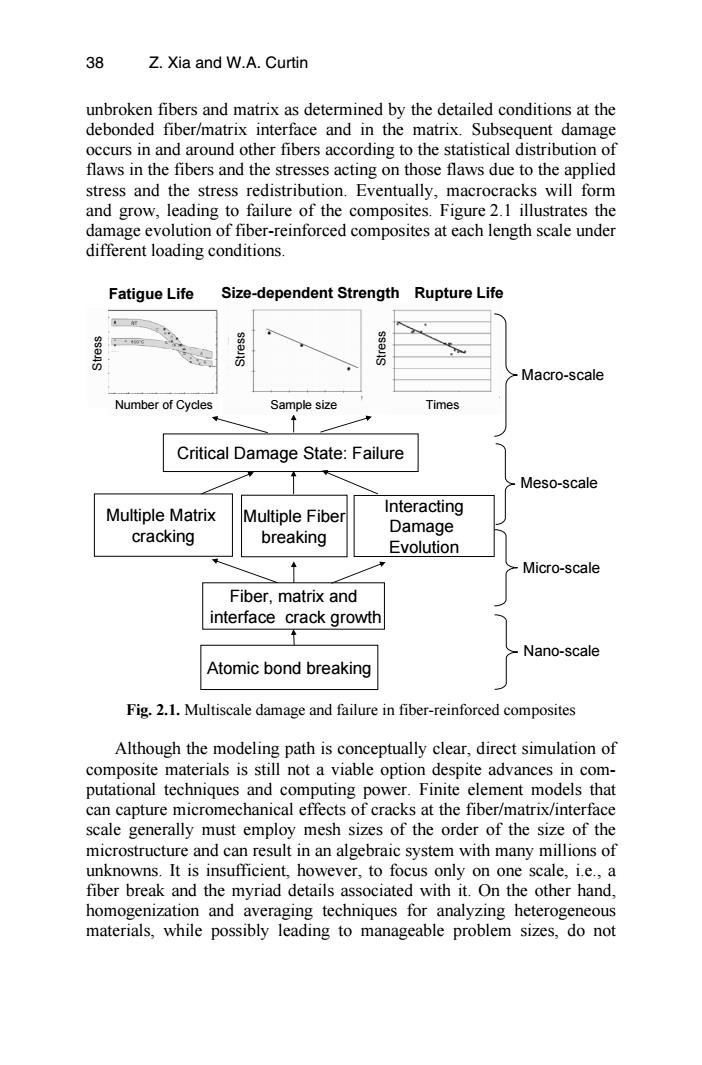正在加载图片...

38 Z.Xia and W.A.Curtin unbroken fibers and matrix as determined by the detailed conditions at the debonded fiber/matrix interface and in the matrix.Subsequent damage occurs in and around other fibers according to the statistical distribution of flaws in the fibers and the stresses acting on those flaws due to the applied stress and the stress redistribution.Eventually,macrocracks will form and grow,leading to failure of the composites.Figure 2.1 illustrates the damage evolution of fiber-reinforced composites at each length scale under different loading conditions. Fatigue Life Size-dependent Strength Rupture Life 鹗 Macro-scale Number of Cycles Sample size Times Critical Damage State:Failure Meso-scale Multiple Matrix Multiple Fiber Interacting cracking breaking Damage Evolution Micro-scale Fiber,matrix and interface crack growth Nano-scale Atomic bond breaking Fig.2.1.Multiscale damage and failure in fiber-reinforced composites Although the modeling path is conceptually clear,direct simulation of composite materials is still not a viable option despite advances in com- putational techniques and computing power.Finite element models that can capture micromechanical effects of cracks at the fiber/matrix/interface scale generally must employ mesh sizes of the order of the size of the microstructure and can result in an algebraic system with many millions of unknowns.It is insufficient,however,to focus only on one scale,i.e.,a fiber break and the myriad details associated with it.On the other hand, homogenization and averaging techniques for analyzing heterogeneous materials,while possibly leading to manageable problem sizes,do notunbroken fibers and matrix as determined by the detailed conditions at the debonded fiber/matrix interface and in the matrix. Subsequent damage occurs in and around other fibers according to the statistical distribution of flaws in the fibers and the stresses acting on those flaws due to the applied stress and the stress redistribution. Eventually, macrocracks will form and grow, leading to failure of the composites. Figure 2.1 illustrates the damage evolution of fiber-reinforced composites at each length scale under different loading conditions. Size-dependent Strength Micro-scale Nano-scale Macro-scale Fatigue Life Rupture Life Fiber, matrix and interface crack growth Multiple Fiber breaking Atomic bond breaking Multiple Matrix cracking Critical Damage State: Failure Interacting Damage Evolution Meso-scale Number of Cycles Sample size Times Stress Stress Stress Fig. 2.1. Multiscale damage and failure in fiber-reinforced composites Although the modeling path is conceptually clear, direct simulation of composite materials is still not a viable option despite advances in computational techniques and computing power. Finite element models that can capture micromechanical effects of cracks at the fiber/matrix/interface scale generally must employ mesh sizes of the order of the size of the microstructure and can result in an algebraic system with many millions of unknowns. It is insufficient, however, to focus only on one scale, i.e., a fiber break and the myriad details associated with it. On the other hand, homogenization and averaging techniques for analyzing heterogeneous materials, while possibly leading to manageable problem sizes, do not 38 Z. Xia and W.A. Curtin